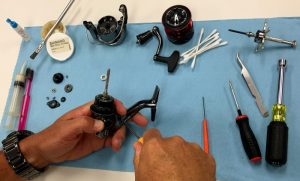
Dive into the world of Fishing Rods and Reel Maintenance with this informative guide. From the importance of regular upkeep to tips on upgrading gear, this topic covers all you need to know to keep your equipment in top shape for your next fishing adventure.
Explore the steps for cleaning and lubricating your fishing gear, learn about inspection and repair techniques, and discover sustainable practices to maintain your equipment while minimizing waste.
Introduction to Fishing Rods and Reel Maintenance
Regular maintenance of fishing rods and reels is crucial to ensure optimal performance and longevity. Neglecting maintenance can lead to various issues that may affect your fishing experience and equipment’s lifespan. By properly caring for your gear, you can enjoy a smoother fishing experience and extend the life of your valuable equipment.
Common Issues from Neglecting Maintenance
- Poor reel performance due to dirt and debris buildup
- Corrosion on rod guides and reel components
- Damaged drag systems leading to inconsistent drag pressure
- Weakened rod blanks and decreased sensitivity
Benefits of a Well-Maintained Fishing Rod and Reel
- Enhanced casting distance and accuracy
- Improved reel smoothness and drag functionality
- Extended lifespan of your fishing gear
- Prevention of costly repairs or replacements
Cleaning and Lubricating Fishing Rods
When it comes to maintaining your fishing gear, cleaning and lubricating your fishing rods is essential to ensure their longevity and optimal performance. Proper maintenance can prevent corrosion, rust, and damage caused by dirt or saltwater.
Cleaning a Fishing Rod
- Start by removing any debris or dirt from the rod using a soft brush or cloth.
- Use a mild soap and water solution to clean the rod gently, avoiding abrasive cleaners that can damage the finish.
- Rinse the rod thoroughly with fresh water to remove any soap residue.
- Dry the rod completely with a clean towel before storing to prevent moisture buildup.
Types of Lubricants for Fishing Reels
- Choose a lubricant specifically designed for fishing reels, such as reel oil or grease.
- Avoid using general-purpose lubricants that may not be suitable for the delicate components of a fishing reel.
- Look for lubricants that are corrosion-resistant and provide smooth operation for your reel.
Properly Lubricating a Fishing Rod
- Apply a small amount of lubricant to key areas of the fishing reel, such as the bearings, gears, and spool shaft.
- Use a cotton swab or applicator to ensure even distribution of the lubricant and avoid excess buildup.
- Rotate the reel handle to distribute the lubricant evenly and ensure smooth operation.
- Regularly check and reapply lubricant as needed, especially after fishing in saltwater or harsh conditions.
Inspection and Repair Techniques

Upon regular cleaning and lubrication of your fishing rod and reel, it is essential to inspect for any damage that may affect their performance. In this section, we will discuss how to inspect for damage, repair minor damages at home, and when it’s best to seek professional repair services.
Inspecting for Damage
- Check the rod for any visible cracks, dents, or loose guides.
- Inspect the reel handle, bail, and drag system for any signs of wear or corrosion.
- Look for any tangled or frayed fishing line that may indicate a problem with the reel.
Repairing Minor Damages at Home
- For minor cracks in the rod, consider using a rod repair kit to fix the damage.
- Replace any damaged or worn-out guides with new ones to ensure smooth line movement.
- Clean and lubricate the reel components regularly to prevent further damage.
Seeking Professional Repair Services
- If you notice major structural damage to the rod or reel, it’s best to consult a professional repair service.
- Professional technicians have the expertise and tools to handle complex repairs effectively.
- Don’t attempt to repair intricate internal components of the reel on your own to avoid causing further damage.
Storage and Protection Tips
Proper storage and protection of your fishing rods and reels are essential to maintain their performance and longevity. By following these tips, you can prevent damage and ensure they are ready for your next fishing adventure.
Storing Fishing Rods
- Store fishing rods in a dry and cool place away from direct sunlight to prevent warping or fading.
- Consider investing in a rod rack or wall mount to keep them organized and prevent bending or breaking.
- Use rod sleeves or covers to protect them from scratches and dings, especially when transporting or storing multiple rods together.
Protecting Rods and Reels from Elements
- Rinse rods and reels with fresh water after each use to remove salt, sand, and debris that can cause corrosion.
- Apply a light coat of reel oil or grease to the reel components to prevent rust and ensure smooth operation.
- Avoid storing rods and reels in damp or humid areas to prevent mold and mildew growth.
Long-Term Storage Tips
- Before storing for an extended period, clean and dry your rods and reels thoroughly to prevent rust and corrosion.
- Loosen the drag on reels to reduce tension on internal components during storage.
- Consider storing rods and reels in protective cases or bags to shield them from dust and moisture.
Upgrading and Customizing Fishing Gear
When it comes to enhancing your fishing experience, upgrading and customizing your fishing gear can make a significant difference. Whether it’s improving performance, durability, or simply personalizing your equipment, there are various benefits to upgrading components in fishing rods and reels.
Benefits of Upgrading Components
- Increased casting distance and accuracy
- Enhanced sensitivity for better bite detection
- Improved drag systems for smoother fights with fish
- Customized aesthetics to match your style
Popular Customization Options
- Upgrading to high-performance bearings for smoother operation
- Installing custom grips or handles for better comfort and control
- Replacing stock guides with high-quality ceramic guides for reduced friction
- Customizing reel spools for specific fishing techniques
Resources for Replacement Parts
When looking for high-quality replacement parts for your fishing gear, it’s essential to choose reputable sources to ensure compatibility and performance. Some trusted resources include:
1. Specialized fishing tackle stores
- Online retailers with good customer reviews
- Manufacturer websites for original components
Sustainable Practices in Fishing Gear Maintenance

When it comes to maintaining your fishing gear, it’s essential to adopt sustainable practices to minimize environmental impact and promote responsible stewardship of our natural resources. By using eco-friendly cleaning products, reducing waste, and disposing of old gear properly, you can contribute to a healthier ecosystem for future generations of anglers.
Eco-Friendly Cleaning and Maintenance Products
Choosing environmentally-friendly cleaning and maintenance products is a simple yet effective way to reduce your carbon footprint. Look for biodegradable cleaners and lubricants that are non-toxic and safe for aquatic ecosystems. By opting for green products, you can keep your gear in top condition without harming the environment.
Minimizing Waste in Gear Maintenance
One way to minimize waste when maintaining fishing equipment is to invest in high-quality gear that is built to last. By choosing durable rods and reels, you can reduce the need for frequent replacements and ultimately lessen the amount of waste generated. Additionally, consider repairing and reusing components whenever possible to extend the life of your gear.
Responsible Disposal of Old Fishing Gear
Properly disposing of old fishing gear is crucial to prevent pollution and protect wildlife. Instead of throwing old gear in the trash, explore recycling programs or take advantage of gear trade-in opportunities offered by manufacturers. By recycling or repurposing old gear, you can ensure that it doesn’t end up in landfills or waterways, where it can harm marine life.
Summary
In conclusion, proper maintenance of your fishing rods and reels is crucial for their longevity and performance. By following the tips provided in this guide, you can ensure that your gear stays in top condition for many fishing trips to come.
Question Bank
How often should I clean my fishing rod and reel?
You should clean your fishing rod and reel after each use to prevent dirt and debris from causing damage.
Can I use any type of lubricant on my fishing reel?
No, it’s best to use lubricants specifically designed for fishing reels to ensure proper performance and longevity.
What are some common signs of damage to look for during inspection?
Common signs include rust, corrosion, loose guides, and cracks in the rod.
Is it necessary to store my fishing rods indoors?
Yes, storing your fishing rods indoors protects them from exposure to harsh weather conditions that can cause damage.
How can I upgrade my fishing gear without breaking the bank?
You can consider upgrading individual components or customizing your gear gradually to spread out the costs.





